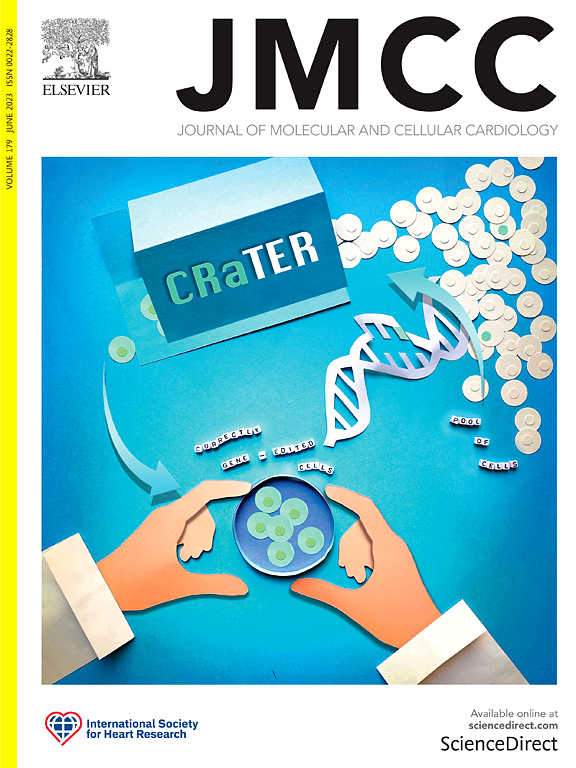MMP-2 inhibition attenuates ER stress-mediated cell death during myocardial ischemia-reperfusion injury by preserving IRE1α
IF 4.9
2区 医学
Q1 CARDIAC & CARDIOVASCULAR SYSTEMS
引用次数: 0
Abstract
Endoplasmic reticulum (ER) stress is one of the major events accompanying myocardial ischemia-reperfusion (IR) injury, as hypoxia and oxidative stress disrupt protein folding in the ER. As a result, the unfolded protein response (UPR) is activated through different sensors including inositol-requiring enzyme 1α (IRE1α) and protein kinase R-like ER kinase (PERK). Failure of the UPR to reduce ER stress induces cellular dysfunction. Matrix metalloproteinase-2 (MMP-2) is a ubiquitous protease that is activated intracellularly in response to oxidative stress and partially localizes near the ER. However, its role in ER homeostasis is unknown. We hypothesized that MMP-2 is involved in the regulation of the UPR and ER stress-mediated apoptosis during IR injury. Isolated mouse hearts subjected to IR injury showed impaired recovery of post-ischemic contractile function compared to aerobically perfused controls. Ventricular extracts from IR hearts had higher levels of glucose-regulated protein-78 and protein disulfide isomerase and lower levels of IRE1α and PERK compared to aerobic controls. MMP-2 inhibitors, ARP-100 or ONO-4817, given 10 min before ischemia, improved cardiac post-ischemic recovery and preserved IRE1α level in hearts subjected to 30 min ischemia/40 min reperfusion. IR also increased the levels of CHOP and mitochondrial Bax and caspase-3 and -9 activities, indicating induction of apoptosis, all of which were attenuated by MMP-2 inhibitors, regardless of the reperfusion time. Immunoprecipitation showed an association between MMP-2 and IRE1α in aerobic and IR hearts. During myocardial IR injury MMP-2 may impair the UPR and induce apoptosis by proteolysis of IRE1α. Inhibition of MMP-2 activity protects against cardiac contractile dysfunction in part by preserving IRE1α and preventing the progression to myocardial cell death.

抑制MMP-2可通过保留IRE1α来减轻心肌缺血再灌注损伤时内质网应激介导的细胞死亡。
内质网(ER)应激是心肌缺血再灌注(IR)损伤的主要事件之一,因为缺氧和氧化应激破坏了内质网中的蛋白质折叠。因此,未折叠蛋白反应(UPR)通过不同的传感器被激活,包括肌醇要求酶1α (IRE1α)和蛋白激酶r样ER激酶(PERK)。UPR减少内质网应激的失败会导致细胞功能障碍。基质金属蛋白酶-2 (Matrix metalloproteinase-2, MMP-2)是一种普遍存在的蛋白酶,在细胞内响应氧化应激时被激活,部分定位于内质网附近。然而,其在内质网稳态中的作用尚不清楚。我们假设MMP-2参与了IR损伤中UPR和内质网应激介导的细胞凋亡的调控。与有氧灌注对照相比,受IR损伤的离体小鼠心脏显示缺血后收缩功能的恢复受损。与有氧对照相比,IR心脏的心室提取物具有更高水平的葡萄糖调节蛋白-78和蛋白二硫异构酶,以及更低水平的IRE1α和PERK。MMP-2抑制剂,ARP-100或ONO-4817,在缺血前10 min给予,改善心脏缺血后恢复,并保持心脏缺血30 min /再灌注40 min的IRE1α水平。IR还增加了CHOP和线粒体Bax的水平以及caspase-3和-9的活性,表明诱导了细胞凋亡,而这些都被MMP-2抑制剂减弱,与再灌注时间无关。免疫沉淀显示有氧和IR心脏中MMP-2和IRE1α之间存在关联。在心肌IR损伤过程中,MMP-2可能通过IRE1α的蛋白水解而影响UPR并诱导凋亡。抑制MMP-2活性部分通过保留IRE1α和防止心肌细胞死亡的进展来保护心脏收缩功能障碍。
本文章由计算机程序翻译,如有差异,请以英文原文为准。
求助全文
约1分钟内获得全文
求助全文
来源期刊
CiteScore
10.70
自引率
0.00%
发文量
171
审稿时长
42 days
期刊介绍:
The Journal of Molecular and Cellular Cardiology publishes work advancing knowledge of the mechanisms responsible for both normal and diseased cardiovascular function. To this end papers are published in all relevant areas. These include (but are not limited to): structural biology; genetics; proteomics; morphology; stem cells; molecular biology; metabolism; biophysics; bioengineering; computational modeling and systems analysis; electrophysiology; pharmacology and physiology. Papers are encouraged with both basic and translational approaches. The journal is directed not only to basic scientists but also to clinical cardiologists who wish to follow the rapidly advancing frontiers of basic knowledge of the heart and circulation.

 求助内容:
求助内容: 应助结果提醒方式:
应助结果提醒方式:


